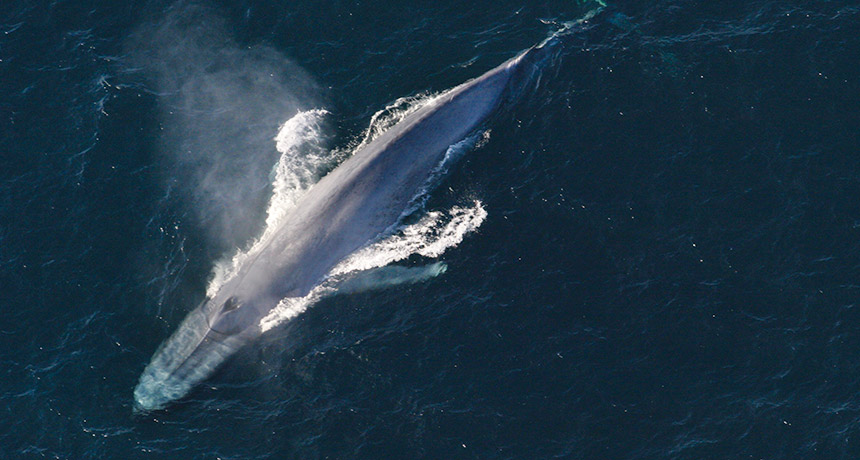Most blue whales are ‘righties,’ except for this one move

Blue whales, it turns out, are a tad ambidextrous.
When hunting in deep water, the whales tend to be “right-handed,” lunging at krill while twisting 180 degrees or less onto their right side. But when gobbling up the tiny crustaceans near the surface, the whales tend to be lefties, launching themselves upward while performing a 360-degree barrel roll to the left, researchers report in the Nov. 20 Current Biology. Rolling to the left at the surface may help the whales better see food with their dominant right eye, the scientists say.
Many vertebrates tend to favor one side of the body over the other for certain tasks. This lateralization, or handedness, helps animals be more efficient at those jobs and has even been spotted in tiny crevice-dwelling ants (SN: 1/24/15, p. 11). The new research is the first to document handedness in blue whales and the first evidence of a marine mammal favoring a different side of its body depending on feeding depth, the researchers say.
Though handedness has been described in other whales before, this study “demonstrates that you really need to consider the context of how animals are feeding in their environment,” says study coauthor Ari Friedlaender, an ecologist at the University of California, Santa Cruz.
Friedlaender and colleagues monitored blue whales off the coast of California using remote control–sized trackers from 2010 to 2014. Of 49 whales, 57 percent preferred to roll to one side than the other. Of whales that showed handedness, 75 percent tended to roll to the right.
But when feeding near the surface, whales tended to use the larger, more acrobatic roll to the left. This left-handed barrel roll may be a strategic move to help whales use their better eye to see less-dense patches of krill that congregate near the surface, Friedlaender and colleagues speculate. The right eye is connected to the left side of the brain, which controls aspects of coordination, motor control and the ability to plan actions.
Neuroscientist Lesley Rogers of the University of New England in Armidale, Australia, agrees that whales may be using left-handed turns because of the connection between the right eye and the brain’s left hemisphere. “We know from detailed research on chicks, amphibians and fish that the right eye and left hemisphere control feeding responses,” she says. But she remains cautious until scientists know for sure which eye the whales are relying on when spiraling to the left. “It all depends on how the whale is processing information and which eye or hemisphere it is using [while rolling].”
